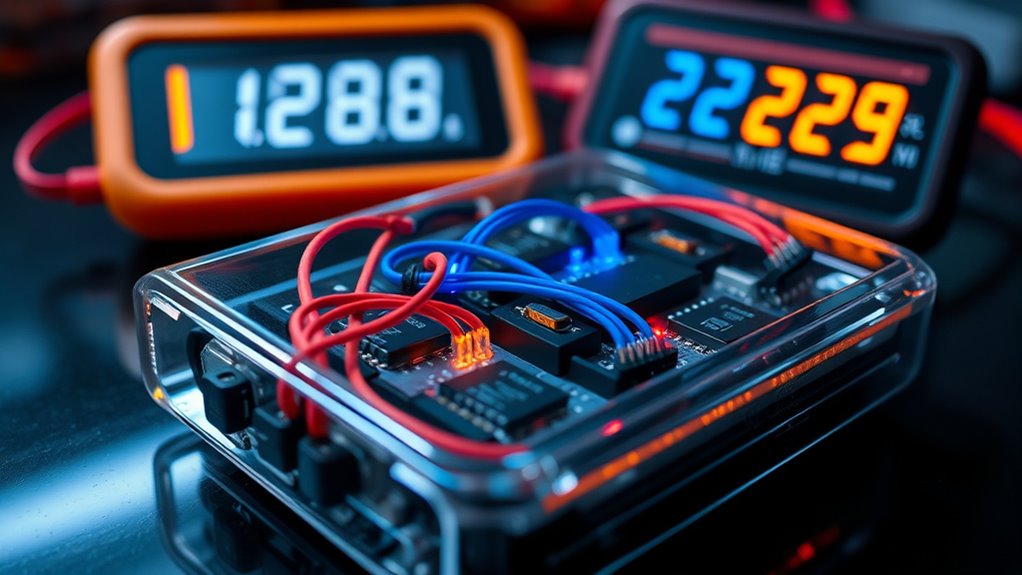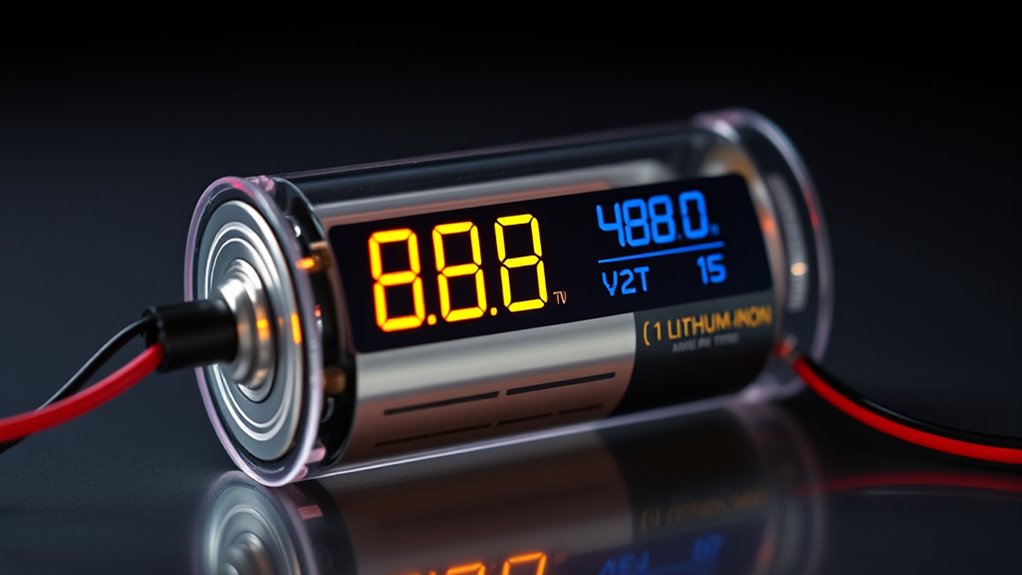Understanding voltage, current, and capacity helps you grasp how a battery powers your devices. Voltage is the electrical pressure that pushes electrons, determining how much power the battery can deliver—higher voltage means more potential energy. Current is the flow rate of electrons, showing how much power a device draws at a time. Capacity indicates how long the battery can run before needing a recharge. Mastering these concepts guarantees you select and care for batteries effectively for better performance.
Key Takeaways
- Voltage measures the electrical pressure that pushes current through a circuit, influencing device power requirements.
- Current indicates the flow of electrons, determining how much power a battery can deliver at a given moment.
- Capacity reflects the total charge a battery can store, affecting how long a device can run before recharging.
- Higher voltage batteries provide more electrical force, often requiring multiple cells in series for higher power devices.
- Proper understanding of all three ensures optimal battery selection, usage, and charging practices for safety and longevity.

Have you ever wondered how batteries power your daily devices? It all comes down to understanding the basic principles of voltage, current, and capacity. When you think about a battery, imagine it as a container of stored energy, ready to deliver power when needed. The key to how effectively it does this lies in its battery chemistry, which determines how the materials inside interact to produce electrical energy. Different chemistries, like lithium-ion or nickel-metal hydride, have unique characteristics affecting voltage levels, lifespan, and safety. Knowing the battery chemistry helps you choose the right type for your device and ensures you’re handling it properly. Voltage is the electrical force that pushes current through a circuit. Think of it as the pressure that drives electrons from the battery’s positive terminal to the negative terminal. Most household batteries, like AA or AAA, have a standard voltage—1.5 volts—while rechargeable batteries, such as lithium-ion cells, often operate at around 3.6 or 3.7 volts. Understanding voltage helps you determine whether a battery can power a specific device or if multiple batteries need to be connected in series to reach the required voltage level. Current, on the other hand, refers to the flow of electrons, or how much charge is moving through the circuit at a given time. It’s measured in amperes, or amps. When you use a device, it draws a certain current from the battery. If the current draw is too high for the battery’s design, it can cause overheating or reduce its lifespan. Conversely, a battery with a higher current capacity can deliver more power without significant voltage drops. This is where capacity comes into play. Battery capacity, measured in milliamp-hours (mAh) or amp-hours (Ah), indicates how much charge the battery can store and deliver over time. A higher capacity means your device can run longer before needing a recharge. Proper charging techniques are critical to maintaining battery health and performance. Understanding charging protocols help extend your battery’s lifespan. Proper charging methods—like avoiding overcharging or deep discharging—help extend your battery’s lifespan. For example, lithium-ion batteries benefit from chargers that regulate voltage and current carefully, preventing damage caused by excessive heat or voltage spikes. For rechargeable batteries, following specific charging protocols ensures the chemistry remains stable and safe. Using the right charger and adhering to recommended charging practices not only prolongs battery life but also maintains consistent voltage and current delivery, so your devices operate reliably. By understanding these fundamental concepts—voltage, current, capacity, and how to charge properly—you gain control over your devices’ performance and longevity.
Frequently Asked Questions
How Do Temperature Changes Affect Battery Voltage and Capacity?
Temperature effects can considerably impact your battery’s voltage and capacity. When it’s cold, your battery’s voltage drops, and capacity variation increases because chemical reactions slow down. Conversely, high temperatures can temporarily boost capacity but may cause long-term damage and reduce overall lifespan. You’ll notice shorter run times in cold weather and potential overheating in hot conditions, so managing temperature is key to maintaining ideal battery performance.
What Is the Relationship Between Battery Aging and Capacity Loss?
As your battery ages, its capacity decreases mainly due to electrode degradation and electrolyte breakdown. Over time, electrodes lose their ability to store and release charge efficiently, reducing overall capacity. Meanwhile, electrolyte breakdown causes internal resistance to increase, limiting current flow. This combination results in shorter usage times and less power available. Regularly monitoring and maintaining your battery can help slow this aging process and extend its lifespan.
Can Two Batteries With the Same Voltage Have Different Capacities?
Yes, two batteries with the same voltage can have different capacities because of variations in battery chemistry and design. Capacity measurement reflects how much charge a battery can store, which isn’t solely determined by voltage. You’ll find that even if their voltages match, differences in materials, age, or manufacturing affect their total capacity, meaning one can hold more energy than the other despite having identical voltages.
How Does Internal Resistance Influence Battery Performance?
Internal resistance impacts your battery’s performance by reducing power efficiency. When internal resistance is high, more energy is lost as heat, causing the battery to deliver less current and shorten its runtime. You might notice slower device response or quicker battery drain. To improve performance, choose batteries with lower internal resistance, which allows for smoother power delivery and better efficiency, especially under high load conditions.
What Safety Measures Are Essential for High-Capacity Batteries?
You must follow strict safety measures for high-capacity batteries, including proper battery disposal, adherence to designated charging protocols, and avoiding overcharging or physical damage. Always use approved chargers and dispose of batteries responsibly to prevent leaks or fires. Keep batteries away from heat sources and handle them with care. Following these safety steps helps protect you, your environment, and prolongs the battery’s lifespan.
Conclusion
Now that you understand how voltage, current, and capacity work together, you can better choose the right battery for your needs. Did you know that the world’s largest battery, in South Australia, can power 50,000 homes for an hour? That’s a huge leap in energy storage! Remember, knowing these basics helps you make smarter decisions and get the most out of your batteries. Keep exploring, and you’ll stay energized for any project ahead!










